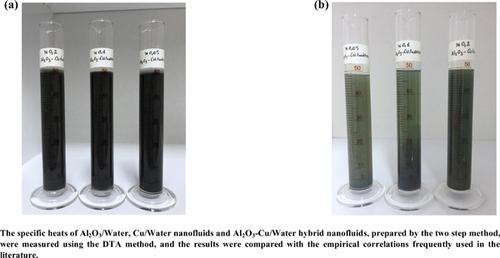Current Nanoscience ( IF 1.4 ) Pub Date : 2020-11-30 , DOI: 10.2174/1573413715666191118105331 Andaç Batur Çolak 1 , Oğuzhan Yıldız 2 , Mustafa Bayrak 1 , Ali Celen 3 , Ahmet Selim Dalkılıç 4 , Somchai Wongwises 5

|
Background: Researchers working in the field of nanofluid have done many studies on the thermophysical properties of nanofluids. Among these studies, the number of studies on specific heat is rather limited. In the study of the heat transfer performance of nanofluids, it is essential to raise the number of specific heat studies, whose subject is one of the important thermophysical properties.
Objective: The authors aimed to measure the specific heat values of Al2O3/water, Cu/water nanofluids and Al2O3-Cu/water hybrid nanofluids using the DTA procedure, and compare the results with those frequently used in the literature. In addition, this study focuses on the effect of temperature and volume concentration on specific heat.
Methods: The two-step method was tried to have nanofluids. The pure water selected as the base fluid was mixed with the Al2O3 and Cu nanoparticles and Arabic Gum as the surfactant, firstly mixed in the magnetic stirrer for half an hour. It was then homogenized for 6 hours in the ultrasonic homogenizer.
Results: After the experiments, the specific heat of nanofluids and hybrid nanofluid were compared and the temperature and volume concentration of specific heat were investigated. Then, the experimental results obtained for all three fluids were compared with the two frequently used correlations in the literature.
Conclusion: Specific heat capacity increased with increasing temperature, and decreased with increasing volume concentration for three tested nanofluids. Cu/water has the lowest specific heat capacity among all tested fluids. Experimental specific heat capacity measurement results are compared by using the models developed by Pak and Cho and Xuan and Roetzel. According to experimental results, these correlations can predict experimental results within the range of ±1%.
中文翻译:

差热分析法测定水基Al 2 O 3 -Cu杂化纳米流体比热容的实验研究
背景:从事纳米流体领域的研究人员对纳米流体的热物理性质进行了许多研究。在这些研究中,关于比热的研究数量相当有限。在研究纳米流体的传热性能中,增加比热研究的数量是必不可少的,其主题是重要的热物理性质之一。
目的:作者旨在使用DTA方法测量Al 2 O 3 /水,Cu /水纳米流体和Al 2 O 3 -Cu /水杂化纳米流体的比热值,并将其与文献中常用的结果进行比较。 。另外,这项研究集中于温度和体积浓度对比热的影响。
方法:尝试采用两步法制备纳米流体。将选择作为基础流体的纯水与Al 2 O 3和Cu纳米颗粒混合,以及阿拉伯胶作为表面活性剂,首先在磁力搅拌器中混合半小时。然后将其在超声均化器中均化6小时。
结果:经过实验,比较了纳米流体和杂化纳米流体的比热,并研究了比热的温度和体积浓度。然后,将所有三种流体获得的实验结果与文献中经常使用的两种相关性进行比较。
结论:三种测试的纳米流体的比热随温度的升高而增加,随体积浓度的增加而降低。在所有测试流体中,铜/水的比热容最低。使用Pak和Cho和Xuan和Roetzel开发的模型比较了实验比热容测量结果。根据实验结果,这些相关性可以预测±1%范围内的实验结果。











































 京公网安备 11010802027423号
京公网安备 11010802027423号